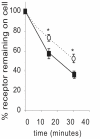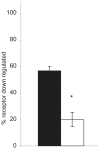RACK1 associates with muscarinic receptors and regulates M(2) receptor trafficking
- PMID: 20976005
- PMCID: PMC2958127
- DOI: 10.1371/journal.pone.0013517
RACK1 associates with muscarinic receptors and regulates M(2) receptor trafficking
Abstract
Receptor internalization from the cell surface occurs through several mechanisms. Some of these mechanisms, such as clathrin coated pits, are well understood. The M(2) muscarinic acetylcholine receptor undergoes internalization via a poorly-defined clathrin-independent mechanism. We used isotope coded affinity tagging and mass spectrometry to identify the scaffolding protein, receptor for activated C kinase (RACK1) as a protein enriched in M(2)-immunoprecipitates from M(2)-expressing cells over those of non-M(2) expressing cells. Treatment of cells with the agonist carbachol disrupted the interaction of RACK1 with M(2). We further found that RACK1 overexpression inhibits the internalization and subsequent down regulation of the M(2) receptor in a receptor subtype-specific manner. Decreased RACK1 expression increases the rate of agonist internalization of the M(2) receptor, but decreases the extent of subsequent down-regulation. These results suggest that RACK1 may both interfere with agonist-induced sequestration and be required for subsequent targeting of internalized M(2) receptors to the degradative pathway.
Conflict of interest statement
Figures






References
-
- Pierce KL, Luttrell LM, Lefkowitz RJ. New mechanisms in heptahelical receptor signaling to mitogen activated protein kinase cascades. Oncogene. 2001;20:1532–1539. - PubMed
-
- Claing A, Laporte SA, Caron MG, Lefkowitz RJ. Endocytosis of G protein-coupled receptors: roles of G protein-coupled receptor kinases and beta-arrestin proteins. Prog Neurobiol. 2002;66:61–79. - PubMed
-
- von Zastrow M. Mechanisms regulating membrane trafficking of G protein-coupled receptors in the endocytic pathway. Life Sci. 2003;74:217–224. - PubMed
-
- Le Roy C, Wrana JL. Clathrin- and non-clathrin-mediated endocytic regulation of cell signalling. Nat Rev Mol Cell Biol. 2005;6:112–126. - PubMed
-
- Nichols B. Caveosomes and endocytosis of lipid rafts. J Cell Sci. 2003;116:4707–4714. - PubMed
Publication types
MeSH terms
Substances
Grants and funding
LinkOut - more resources
Full Text Sources
Molecular Biology Databases

